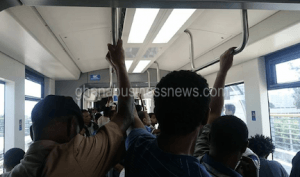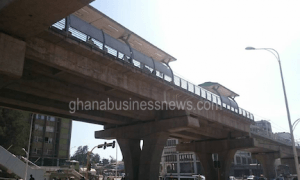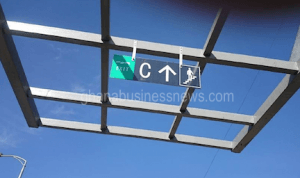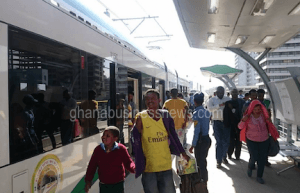Riding the rails in Addis Ababa

In the last couple of weeks Ethiopia has literally been shining as a country.
The country’s international ratings seem to have soared when the country launched its light rail system in the capital Addis Ababa. It became the first country in sub-Sahara Africa to do so. And the country is now being used as a shining example in infrastructure development for many African countries including Ghana.
But come to think of it. Only about 30 years ago, Ethiopia and current day Eritrea suffered famine. Eritrea was part of Ethiopia until the two-year war that led to Eretrea seceding at the end of the war in 2000.
It was the worst famine to hit the country in about a century.
Ethiopia however has risen from the ashes and is standing tall among the best on the continent. The country is also confirming the argument of existing development literature that one-party states do better when it comes to development, even though human rights issues always remain thorny.
The ruling party in Ethiopia holds 100 per cent of the country’s parliamentary seats.
That is also among others some of the things some investors and foreign commentators hold against Ethiopia, the lack of political choice and free expression.
The country is also the largest producer of coffee in sub-Saharan Africa, producing about 39 per cent of the total quantity of coffee produced in Africa.

When I recently went back to Ethiopia for a week in mid October, I decided that one of the things I would do before I returned to Ghana was to ride the light rail system.
I have travelled on the Underground in London, been on the tram that stops by Cavendish Road somewhere near Blackpool in the UK. Used the train in Boston, USA, and I have used the subway in New York City where I went for graduate studies, and I thoroughly enjoyed the experiences. Travelling by train is hassle free in my view, never mind the crowded No.1 train that stops by Columbia University, and of course there is very little or no traffic.
The trip on the rail in Addis was eventful, even emotional.
I remembered the first time I arrived in Addis Ababa on October 24, 2011. I had just returned three days earlier to Ghana after a two-week trip to the US, which was also my first.
What I saw on the streets of Addis Ababa in the cold dusty night was unsettling. I was struck hard in the face by the presence of the city’s homeless – hurdled together in large numbers and sleeping in the middle of the streets. It wasn’t that I haven’t seen homeless people in the streets of other countries before. I have seen homeless men and women on the streets of Accra, Lome, Lagos and Benin. I have seen homeless people in Agadir, Morocco, Washington DC and Des Moines in the US. But what I saw in Addis Ababa troubled my very soul.
Someone I met in Addis Ababa on latter visits told me, the city has improved. “If you have been here even five years ago, you would have seen far worse,” the person said.

But the Addis Ababa of 2015 is a transformed city. Indeed, Ethiopia is among the few countries expected to achieve all the Millennium Development Goals. The economy has been growing continuously for the last 10 years. In 2013-2014, the economy grew at 10.8 per cent, making it one of the five fastest growing economies in the world according to the International Monetary Fund.
A recent study of taxes, poverty and inequality carried by the CEQ Institute says Ethiopia is also doing well in redistribution of funds to the poor.
I went on the train ride on October 16, 2015 with two friends. A Ghanaian colleague and an Ethiopian friend who was also making the train ride for the first time himself.
My Ethiopian friend like myself had used trains in some parts of the world. But we were all expecting to have an exhilarating ride.
When we approached the station at Lagar near the stadium we were heading straight to the platform to get our tickets, but we were motioned by another passenger to get our tickets from the booth on the ground before we climbed the stairs

The ride from one end of the station to the other cost us four Ethiopian birr each, which is less than one US cent.
From Lagar, near Addis Ababa’s main stadium, the ride went through Mexico Square, Lideta, Abinet, Merkato, Autobus Tera (Bus Station), Atikelt Tera and we finally stopped at the end of the trip in the tunnel at the Menelik II Square.
The train was filled to capacity, there was hardly enough room to stretch. Every single passenger on the train wore a radiant smile, and exuded some nationalistic pride. What better time to be Ethiopian!
The tracks go above the roads and some parts are underground!
But sadly, China is written all over the entire project. The passenger cabins were smaller than expected, and the seats were smaller as well with very little space – an indication that the coaches were built with Chinese bodies in mind. It is impossible for two people to sit opposite each other on the separate seats meant for two passengers each.
I saw workers at some of the stations crossing the tracks to sweep and clear stuff. That isn’t good enough.
I was told during the launch, cabin crews in uniform were introduced, but when the train started operations, their presence in the cars were seen to be impractical and so they were withdrawn.
The investment of about $475 million into the project would be worth the while as it obviously has improved transportation in the centre of Addis Ababa, and possibly the economic benefits would follow.
By Emmanuel K. Dogbevi
Email: edogbevi@gmail.com
Copyright © 2015 by Creative Imaginations Publicity
All rights reserved. This article or any portion thereof may not be reproduced or used in any manner whatsoever without the express written permission of the publisher except for the use of brief quotations in reviews.

Three points need correction:the time when Eriteria seceded from Ethiopia, the end to end referrence & the exchange rate b/ n the local currency, the Birr, & the U.S. dollar. Eriteria was informally suceeded from Ethiopia in 1991 & then in 1993 with psuedo referrendum. Leghar is a middle point and not an end point on the distance covered by the train. And finally, the exchange rate of the birr at the moment is 1 USD to 20.90 Birr. Based on this rate you exchange 4 Birr for about 21 U.S. cents & not 1 cent. The longest distance covered by the train costs 6 Birr which is still chip.
Thanks Mulugeta for the corrections. I appreciate.